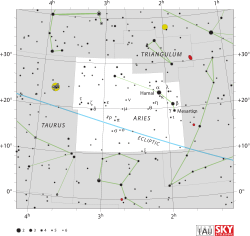Kappa Arietis

| |
| Observation data Epoch J2000.0 Equinox J2000.0 | |
|---|---|
| Constellation | Aries |
| Right ascension | 02h 06m 33.92388s[1] |
| Declination | +22° 38′ 53.9267″[1] |
| Apparent magnitude (V) | 5.02[2] |
| Characteristics | |
| U−B color index | +0.11[2] |
| B−V color index | +0.12[2] |
| Astrometry | |
| Radial velocity (Rv) | +11.5[3] km/s |
| Proper motion (μ) | RA: +17.86[1] mas/yr Dec.: –37.55[1] mas/yr |
| Parallax (π) | 17.96 ± 0.37 mas |
| Distance | 182 ± 4 ly (56 ± 1 pc) |
| Details | |
| Surface gravity (log g) | 4.0[4] cgs |
| Temperature | 8,700[4] K |
| Metallicity [Fe/H] | +0.18[4] dex |
| Rotational velocity (v sin i) | 18[5] km/s |
| Other designations | |
Kappa Arietis (κ Ari, κ Arietis) is the Bayer designation for a binary star in the northern constellation of Aries. It is approximately 182 light-years (56 parsecs) distant from Earth. The combined apparent visual magnitude of the pair is 5.02,[2] making the system bright enough for it to be dimly visible to the naked eye. Kappa Arietis is a double-lined spectroscopic binary with both components displaying the spectral properties of an Am, or metallic-lined star. They have nearly the same brightness and their mass ratio is 1.03; very close to equal.[4] Their orbital period is 15.2938 days and they have a high eccentricity of 0.61.[7]
References
- ↑ 1.0 1.1 1.2 1.3 van Leeuwen, F. (November 2007), "Validation of the new Hipparcos reduction", Astronomy and Astrophysics 474 (2): 653–664, arXiv:0708.1752, Bibcode:2007A&A...474..653V, doi:10.1051/0004-6361:20078357.
- ↑ 2.0 2.1 2.2 2.3 Mendoza, E. E.; Gomez, V. T.; Gonzalez, S. (June 1978), "UBVRI photometry of 225 AM stars", Astronomical Journal 83: 606–614, Bibcode:1978AJ.....83..606M, doi:10.1086/112242.
- ↑ Wilson, Ralph Elmer (1953), General Catalogue of Stellar Radial Velocities, Washington: Carnegie Institution of Washington, Bibcode:1953QB901.W495......
- ↑ 4.0 4.1 4.2 4.3 Mitton, J. (January 1977), "Spectroscopic observations and curve-of-growth analyses of the four A stars omicron Peg, beta Ari, kappa Ari and 32 Vir", Astronomy and Astrophysics, Supplemental Series 27: 35–46, Bibcode:1977A&AS...27...35M.
- ↑ Royer, F. et al. (October 2002), "Rotational velocities of A-type stars in the northern hemisphere. II. Measurement of v sin i", Astronomy and Astrophysics 393: 897–911, arXiv:astro-ph/0205255, Bibcode:2002A&A...393..897R, doi:10.1051/0004-6361:20020943.
- ↑ "kap Ari -- Variable Star", SIMBAD Astronomical Database (Centre de Données astronomiques de Strasbourg), retrieved 2012-08-04.
- ↑ Abt, Helmut A. (August 2005), "Observed Orbital Eccentricities", The Astrophysical Journal 629 (1): 507–511, Bibcode:2005ApJ...629..507A, doi:10.1086/431207.
External links
| ||||||||||||||||||||||||||||||||||||||||||||||||||||